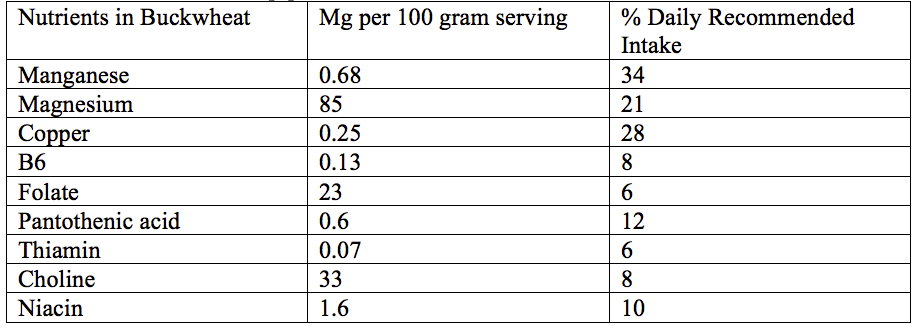
Are You Eating Buckwheat?
Buckwheat may be one of the healthiest foods you’re not eating. Along with having numerous health benefits, it is tasty, easy to prepare and inexpensive. Here are some things I love about it:
Buckwheat is not a grain.
Many who are trying to avoid grains find themselves limited to fruit and sweet potatoes as sources of good carbs. Even though it’s often included in lists of grains, buckwheat is not a grain. The edible portion is a seed from a plant related to greens like rhubarb and sorrel.
Buckwheat is gluten-free.
Because it is neither a grain nor related to wheat, buckwheat is gluten-free and safe for those with celiac disease and gluten sensitivities. Studies show that even in high concentrations, buckwheat flour and its purified proteins have no immunologic reactions for patients with celiac disease.1
Buckwheat is high in essential nutrients.
It is rich in many trace minerals, including manganese, magnesium and copper. It is also a good source of the B vitamins: B6, pantothenic acid, niacin, folate, thiamin and choline.
Nutrients in Buckwheat.2

Buckwheat has resistant fiber.
Resistant fiber is a compound shown to lower blood sugar after meals, help weight loss, reduce food cravings and improve diabetes.3 All versions of buckwheat contain resistant fiber, but the boiled kernels, called groats, contain the most at 6 percent or greater.4
Buckwheat has several novel nutraceuticals.
Rutin, quercetin and other bioflavonoids:
These compounds have been shown to strengthen small blood vessels, which can prevent easy bruising, hemorrhoids and varicose veins. Rutin can also help prevent blood clots, lower LDL cholesterol and the production of histamine, which can improve airborne allergies and food intolerances.5
Tannins:
Tannins are astringent phenolic compounds most commonly found in tea. They are also present in significant amounts in buckwheat. Tannins have been shown to reduce bacterial and viral infections and improve diabetes. Along with the mix of insoluble and resistant fiber, the tannins in buckwheat can improve important strains of bowel flora, such as lactobacillus and bacteroidetes, while reducing yeast and harmful bacteria.6
D-chiro inositol:
D-chiro inositol is an exciting compound that may improve many important elements of blood sugar metabolism (such as production of glycogen and insulin sensitivity). Data suggests it may improve polycystic ovarian syndrome (PCOS) 7 and type 2 diabetes.8
Bound antioxidants:
Recent data from cancer researchers has shown we may have been ignoring an important type of antioxidants. We have mostly considered the antioxidants in fruits and vegetables since most of these are readily available and easy to test in lab studies. Now, it is becoming clear a new category of antioxidants, called bound antioxidants, may be even more important. These are found in buckwheat and some grains and are activated by the bowel flora. Buckwheat is rich in bound antioxidants like glutathione and superoxide dismutase. These compounds are also heat stable and survive the cooking process with buckwheat.9

How to use buckwheat.
If you’ve never made it before, don’t worry. Buckwheat is easy to work with. It comes in the form of groats (toasted or raw), noodles and flour. The raw groats are available completely raw or sprouted. The completely raw groats work great for making a grain-free, hot cereal. I don’t use the flour much because baking entails dairy, eggs, oils and sweeteners. I’d rather not bother with all the substitutes and labor.
Try these recipes!
Buckwheat Porridge
Ingredients:
- 1 cup raw buckwheat groats
- 3 cups water
- Liquid Stevia
- Powdered cardamom
Instructions:
- Place buckwheat and water in a 1-quart saucepan.
- Heat on low 45 minutes or until a porridge-like consistency is reached.
- Add stevia and cardamom to taste.
- Serve plain or with unsweetened flax milk or unsweetened coconut yogurt.
Makes: 4 servings
Sprouted Raw Groats
Raw buckwheat is easy to sprout at home with a sprouting tray. Just soak the groats for 30 minutes in cold water, rinse several times and place in sprouting tray. Rinse twice daily. They do not grow into long, grassy sprouts (like mung bean or wheat grass). Rather, the seeds open just slightly and become softer and more digestible. This typically takes three days.
You can also purchase pre-sprouted raw groats, such as found in the Go Raw brand of buckwheat granola. Sprouted buckwheat comes ready to eat. Use it like granola, but know that it is a concentrated food. A few tablespoons is a full serving. I love buckwheat sprouts as a portable food for hikes or long runs. They take up very little space and provide lots of energy.
Buckwheat Trail Mix
Ingredients:
- 1 cup sprouted buckwheat
- 1/3 cup dried currants or diced raisins
- 1 tbsp. sea salt crystals (non-iodized salt, Diamond, or Mortons brands)
Instructions:
- Combine all ingredients.
- Store in a cool, dry place out of light.
- Pack in snack-sized, Ziploc bags for a portable snack.
- Plan on 1/4 cup per 90-120 minutes of activity. It is that concentrated.
Makes: 5 servings
Toasted groats are also called kasha (not Kashi) and can be found in the kosher section of most grocery stores. They make a great substitute for rice as a side dish.
Kasha Pilaf
Ingredients:
- 1 cup kasha
- 1 cup water
- 1 cup vegetable broth
Instructions:
- Place all ingredients in a 1-quart saucepan.
- Bring to a simmer.
- Steam kasha for 20 minutes or until liquid is absorbed.
- Let sit covered for 10 minutes.
- Serve or refrigerate.
Makes: 4 servings
Buckwheat noodles are popular in Asian cuisine for good reason. Along with all the health benefits of buckwheat, I prefer their taste and texture over any of the gluten-free, grain-based noodles I’ve tried. They cook fast and are great served hot or cold.
Buckwheat Noodles and Ume Paste
Ingredients:
- 1 8-ounce package buckwheat noodles (also called soba)
- 1 tbsp. ume plum paste (found in Asian or macrobiotic sections of many larger supermarkets)
- 2 tsp. Tamari (wheat-free, fermented soy sauce)
- 2 tsp. cold-pressed, toasted sesame seed oil
- 2 green onions, sliced
Instructions:
- Bring two quarts of water to a boil. Add a pinch of salt.
- Cook noodles 5-7 minutes until flexible but firm, stirring frequently.
- Rinse noodles in cold water, blot dry.
- Pour noodles into a large serving bowl.
- Stir in all other ingredients.
Makes: 6 servings
Try having buckwheat twice weekly for the next month. Keep a close eye on your digestion, your weight, how easily you can move without pain, how stable your blood sugar is and the health of your skin. You might see some good, healthy improvements!
Sources
1. de Francischi ML1, Salgado JM, da Costa CP. Immunological analysis of serum for buckwheat fed celiac patients. Plant Foods Hum Nutr. 1994 Oct;46(3):207-11.
2. The Food Processor, Version 10.12.0, ESHA Research, Salem, Oregon, USA.
3. Birt DF, Boylston T, Hendrich S, Jane JL, Hollis J, Li L, McClelland J, Moore S, Phillips GJ, Rowling M, Schalinske K, Scott MP, Whitley EM. Resistant starch: promise for improving human health. Adv Nutr. 2013 Nov 6;4(6):587-601. doi: 10.3945/an.113.004325. eCollection 2013 Nov. Review.
4. Skrabanja V, Liljeberg Elmståhl HG, Kreft I, Björck IM. Nutritional properties of starch in buckwheat products: studies in vitro and in vivo. J Agric Food Chem. 2001 Jan;49(1):490-6.
5. Sharma S, Ali A, Ali J, Sahni JK, Baboota S. Rutin: therapeutic potential and recent advances in drug delivery. Expert Opin Investig Drugs. 2013 Aug;22(8):1063-79. doi: 10.1517/13543784.2013.805744. Epub 2013 Jun 25.
6. Serrano J, Puupponen-Pimiä R, Dauer A, Aura AM, Saura-Calixto F. Tannins: current knowledge of food sources, intake, bioavailability and biological effects. Mol Nutr Food Res. 2009 Sep;53 Suppl 2:S310-29. doi: 10.1002/mnfr.200900039.
7. Unfer V1, Porcaro G. Updates on the myo-inositol plus D-chiro-inositol combined therapy in polycystic ovary syndrome. Expert Rev Clin Pharmacol. 2014 Sep;7(5):623-31. doi: 10.1586/17512433.2014.925795. Epub 2014 Jun 5.
8. Larner J, Brautigan DL, Thorner MO. D-chiro-inositol glycans in insulin signaling and insulin resistance. Mol Med. 2010 Nov-Dec;16(11-12):543-52. doi: 10.2119/molmed.2010.00107. Epub 2010 Aug 27.
9. Zieliński H, Michalska A, Piskuła MK, Kozłowska H. Antioxidants in thermally treated buckwheat groats. Mol Nutr Food Res. 2006 Sep;50(9):824-32.

Dr. Alan Glen Christianson (Dr. C) is a Naturopathic Endocrinologist and the author of The NY Times bestselling Adrenal Reset Diet.
Dr. C’s gift for figuring out what really works has helped hundreds of thousands of people reverse thyroid disease, lose weight, and regain energy. Learn more about the surprising story that started his quest.

